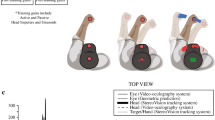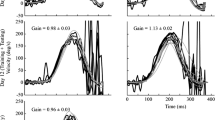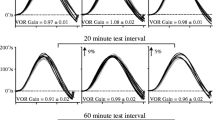Abstract
The vestibulo-ocular reflex (VOR) is the main gaze stabilising system during rapid head movements. The VOR is highly plastic and its gain (eye/head velocity) can be increased via training that induces an incrementally increasing retinal image slip error signal to drive VOR adaptation. Using the unilateral incremental VOR adaptation technique and horizontal active head impulses as the vestibular stimulus, we sought to determine the factors important for VOR adaptation including: the total training time, ratio and number of head impulses to each side (adapting and non-adapting sides; the adapting side was pseudo-randomised left or right) and exposure time to the visual target during each head impulse. We tested 11 normal subjects, each over 5 separate sessions and training protocols. The basic training protocol (protocol one) consisted of unilateral incremental VOR adaptation training lasting 15 min with the ratio of head impulses to each side 1:1. Each protocol varied from the basic. For protocol two, the ratio of impulses were in favour of the adapting side by 2:1. For protocol three, all head impulses were towards the adapting side and the training only lasted 7.5 min. For protocol four, all impulses were towards the adapting side and lasted 15 min. For protocol five, all head impulses were to the adapting side and the exposure time to the visual target during each impulse was doubled. We measured the active and passive VOR gains before and after the training. Albeit with small sample size, our data suggest that the total training time and the visual target exposure time for each head impulse affected adaptation, whereas the total number and repetition rate of head impulses did not. These data have implications for vestibular rehabilitation, suggesting that quality and duration of VOR adaptation exercises are more important than rapid repetition of exercises.



Similar content being viewed by others
References
Bahill AT, McDonald JD (1983a) Model emulates human smooth pursuit system producing zero-latency target tracking. Biol Cybern 48:213–222
Bahill AT, McDonald JD (1983b) Smooth pursuit eye movements in response to predictable target motions. Vis Res 23:1573–1583
Barnes GR, Goodbody S, Collins S (1995) Volitional control of anticipatory ocular pursuit responses under stabilised image conditions in humans. Exp Brain Res 106:301–317
Bartl K, Lehnen N, Kohlbecher S, Schneider E (2009) Head impulse testing using video-oculography. Ann N Y Acad Sci 1164:331–333
Carcaud J, França de Barros F, Idoux E, Eugène D, Reveret L, Moore LE, Vidal PP, Beraneck M (2017) Long-lasting visuo-vestibular mismatch in freely-behaving mice reduces the vestibulo-ocular reflex and leads to neural changes in the direct vestibular pathway. eNeuro 4:1
Carey JP, Minor LB, Peng GC, Della Santina CC, Cremer PD, Haslwanter T. Changes in the three-dimensional angular vestibulo-ocular reflex following intratympanic gentamicin for Ménière's disease. J Assoc Res Otolaryngol 3:430-443, 2002
Carriot J, Jamali M, Brooks JX, Cullen KE. Integration of canal and otolith inputs by central vestibular neurons is subadditive for both active and passive self-motion: implication for perception. J Neurosci 35: 3555–3565, 2015
Clendaniel RA, Lasker DM, Minor LB (2001) Horizontal vestibuloocular reflex evoked by high-acceleration rotations in the squirrel monkey. IV. Responses after spectacle-induced adaptation. J Neurophysiol 86:1594–1611
Fadaee SB, Migliaccio AA (2016) The effect of retinal image error update rate on human vestibulo-ocular reflex gain adaptation. Exp Brain Res 234:1085–1094
Gauthier GM, Robinson DA (1975) Adaptation of human’s vestibulo-ocular reflex to magnifying glasses. Brain Res 92:331–335
Gonshor A, Melvill Jones G (1976a) Short-term adaptive changes in the human vestibulo-ocular reflex arc. J Physiol 256:361–379
Gonshor A, Melvill Jones G (1976b) Extreme vestibulo-ocular adaptation induced by prolonged optical reversal of vision. J Physiol 256:381–414
Grossman GE, Leigh RJ, Abel LA, Lanska DJ, Thurston SE (1988) Frequency and velocity of rotational head perturbations during locomotion. Exp Brain Res 70:470–476
Halmagyi GM, Curthoys IS (1988) A clinical sign of canal paresis. Arch Neurol 45:737–739
Hübner PP, Khan SI, Migliaccio AA (2014) Velocity-selective adaptation of the horizontal and cross-axis vestibulo-ocular reflex in the mouse. Exp Brain Res 232:3035–3046
Hübner PP, Khan SI, Migliaccio AA (2015) The mammalian efferent vestibular system plays a crucial role in the high-frequency response and short-term adaptation of the vestibuloocular reflex. J Neurophysiol 114:3154–3165
Kagerer FA, Contreras-Vidal JL, Stelmach GE (1997) Adaptation to gradual as compared with sudden visuo-motor distortions. Exp Brain Res 115(3):557–561
Kettner RE, Leung HC, Peterson BW (1996) Predictive smooth pursuit of complex two-dimensional trajectories in monkey: component interactions. Exp Brain Res 108:221–235
Khan SI, Hübner PP, Brichta AM, Smith DW, Migliaccio AA (2017) Aging reduces the high-frequency and short-term adaptation of the vestibulo-ocular reflex in mice. Neurobiol Aging 51:122–131
Kilgard MP, Merzenich MM (2002) Order-sensitive plasticity in adult primary auditory cortex. Proc Natl Acad Sci U S A 99:3205–3209
Körding KP, Tenenbaum JB, Shadmehr R (2007) The dynamics of memory as a consequence of optimal adaptation to a changing body. Nat Neurosci 10:779–786
Krauzlis RJ, Lisberger SG (1994) Temporal properties of visual motion signals for the initiation of smooth pursuit eye movements in monkeys. J Neurophysiol 72:150–162
Lisberger SG, Pavelko TA, Broussard DM (1994a) Neural basis for motor learning in the vestibuloocular reflex of primates. I. Changes in the responses of brain stem neurons. J Neurophysiol 72:928–953
Lisberger SG, Pavelko TA, Bronte-Stewart HM, Stone LS (1994b) Neural basis for motor learning in the vestibuloocular reflex of primates. II. Changes in the responses of horizontal gaze velocity Purkinje cells in the cerebellar flocculus and ventral paraflocculus. J Neurophysiol 72:954–973
Mahfuz MM, Schubert MC, Todd CJ, Figtree WVC, Khan SI, Migliaccio AA (2018) The effect of visual contrast on human vestibulo-ocular reflex training. J Assoc Res Otolaryngol 19:113–122
McCrea RA, Yoshida K, Evinger C, Berthoz A (1981) The location, axonal arborization and termination sites of eye-movement related secondary vestibular neurons demonstrated by intraaxonal HRP injection in the alert cat. In: Fuchs A, Becker W (eds) Progress in oculomotor research. Elsevier, North Holland, Amsterdam, pp 379–386
McHugh DE, Bahill AT (1985) Learning to track predictable target waveforms without a time delay. Invest Opthalmol Vis Sci 26:932–937
Migliaccio AA, Schubert MC (2013) Unilateral adaptation of the human angular vestibulo-ocular reflex. J Assoc Res Otolaryngol 14:29–36
Migliaccio AA, Schubert MC (2014) Pilot study of a new rehabilitation tool: improved unilateral short-term adaptation of the human angular vestibulo-ocular reflex. Otol Neurotol 35:310–316
Minor LB, Lasker DM, Backous DD, Hullar TE (1999) Horizontal vestibuloocular reflex evoked by high-acceleration rotations in the squirrel monkey. I. Normal responses. J Neurophysiol 82:1254–1270
Mitchell DE, Della Santina CC, Cullen KE (2017) Plasticity within excitatory and inhibitory pathways of the vestibulo-spinal circuitry guides changes in motor performance. Sci Rep 7(853):853
Nagarajan SS, Blake DT, Wright BA, Byl N, Merzenich MM (1998) Practice-related improvements in somatosensory interval discrimination are temporally specific but generalize across skin location, hemisphere, and modality. J Neurosci 18:1559–1570
Paige GD, Sargent EW (1991) Visually-induced adaptive plasticity in the human vestibulo-ocular reflex. Exp Brain Res 84:25–34
Sadeghi SG, Minor LB, Cullen KE (2011) Multimodal integration after unilateral labyrinthine lesion: single vestibular nuclei neuron responses and implications for postural compensation. J Neurophysiol 105:661–673
Schubert MC, Della Santina CC, Shelhamer M (2008) Incremental angular vestibulo-ocular reflex adaptation to active head rotation. Exp Brain Res 191:435–446
Shelhamer M, Robinson DA, Tan HS (1992) Context-specific adaptation of the gain of the vestibulo-ocular reflex in humans. J Vestib Res 2:89–96
Shelhamer M, Tiliket C, Roberts D, Kramer PD, Zee DS (1994) Short-term vestibulo-ocular reflex adaptation in humans. II. Error signals. Exp Brain Res 100:328–336
Shimazu H, Precht W (1966) Inhibition of central vestibular neurons from the contralateral labyrinth and its mediating pathway. J Neurophysiol 29:467–492
Funding
A.A. Migliaccio was supported by The Garnett Passe and Rodney Williams Memorial Foundation, Senior/Principal Research Fellowship in Otorhinolaryngology and Project Grant (2013-15) and NHMRC Development Grant APP105550.
Author information
Authors and Affiliations
Corresponding author
Ethics declarations
Ethical Approval
Participation in this study was voluntary and subjects gave written informed consent before participating as approved by the University of New South Wales, Human Ethics Committee.
Rights and permissions
About this article
Cite this article
Muntaseer Mahfuz, M., Schubert, M.C., Figtree, W.V.C. et al. Human Vestibulo-Ocular Reflex Adaptation Training: Time Beats Quantity. JARO 19, 729–739 (2018). https://doi.org/10.1007/s10162-018-00689-w
Received:
Accepted:
Published:
Issue Date:
DOI: https://doi.org/10.1007/s10162-018-00689-w




